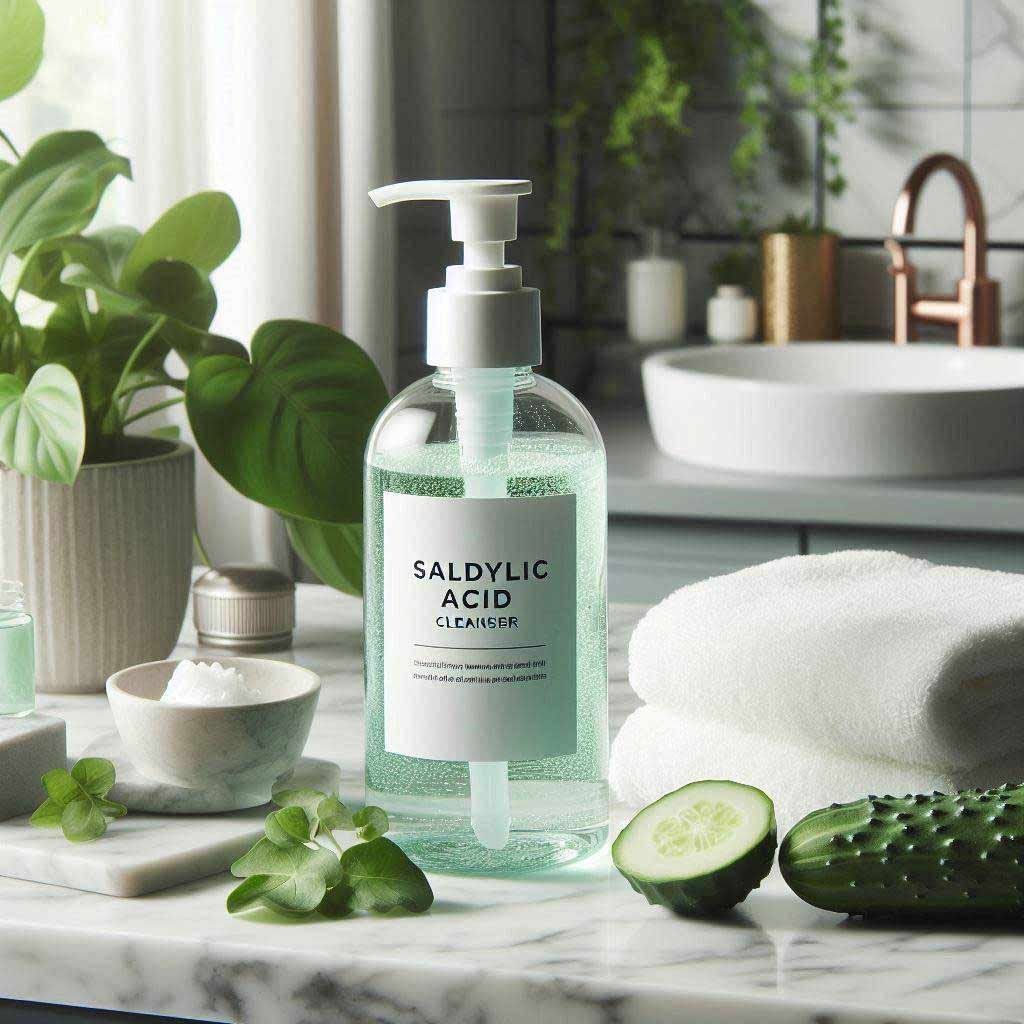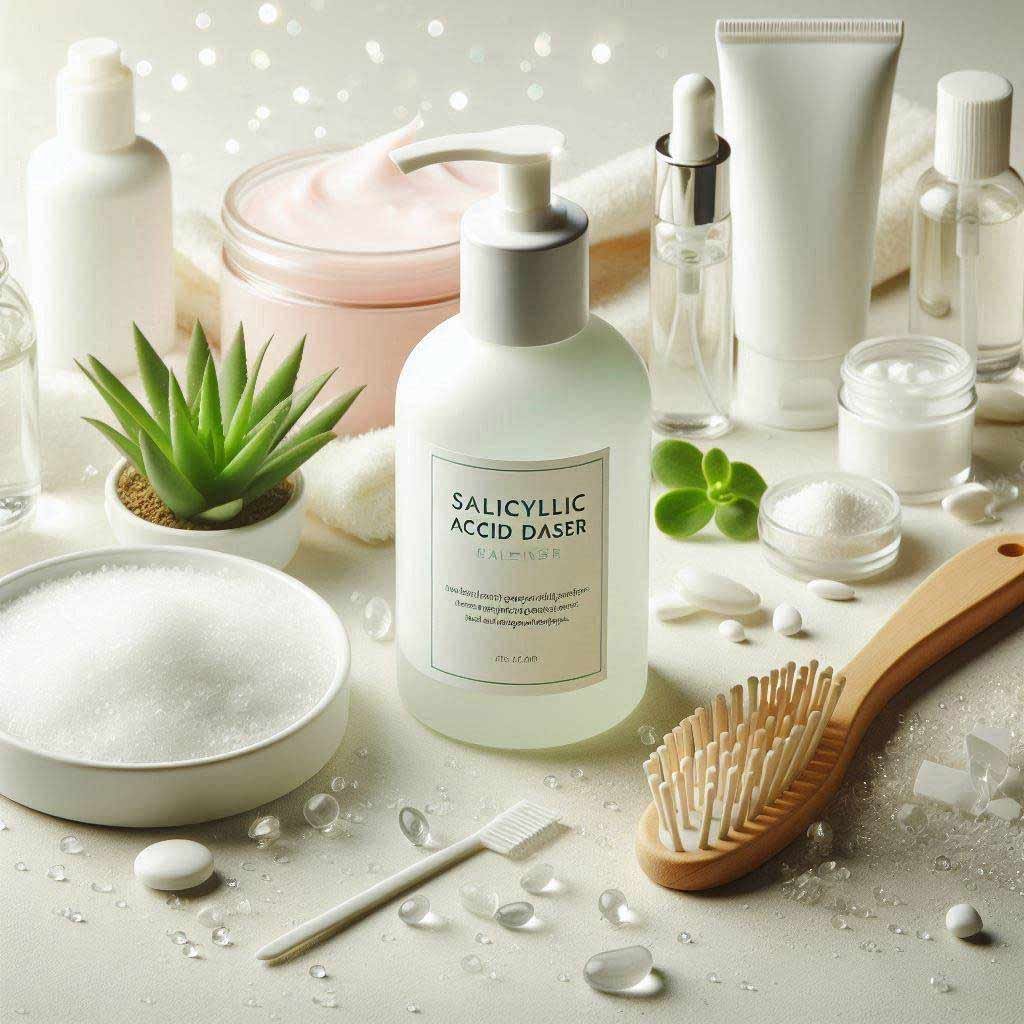Here are 10 of the best salicylic acid cleansers for acne-prone skin, along with their key features and benefits:
CeraVe Renewing SA Cleanser
- Key Ingredients: Salicylic acid, ceramides, and hyaluronic acid.
- Benefits: This cleanser gently exfoliates while restoring the skin’s protective barrier. It’s non-comedogenic and suitable for sensitive skin, making it ideal for daily use.
Neutrogena Oil-Free Acne Wash
- Key Ingredients: 2% salicylic acid and glycerin.
- Benefits: This classic cleanser effectively treats and prevents breakouts. Its oil-free formula helps remove excess oil without over-drying the skin.
Paula’s Choice CLEAR Pore Normalizing Cleanser
- Key Ingredients: 0.5% salicylic acid and soothing ingredients like chamomile.
- Benefits: Designed for acne-prone skin, this gentle formula clears pores and reduces redness. It’s suitable for all skin types and can be used twice daily.
La Roche-Posay Effaclar Medicated Gel Cleanser
- Key Ingredients: 2% salicylic acid and glycolic acid.
- Benefits: This foaming gel cleanser targets acne and helps reduce excess oil. It’s formulated for oily and acne-prone skin, providing a refreshing cleanse.
Cosrx Salicylic Acid Daily Gentle Cleanser
- Key Ingredients: 0.5% salicylic acid and willow bark water.
- Benefits: This gentle cleanser helps control breakouts while maintaining hydration. It’s free from sulfates and parabens, making it suitable for sensitive skin.
Murad Acne Control Clarifying Cleanser
- Key Ingredients: 1.5% salicylic acid and green tea extract.
- Benefits: This cleanser not only targets acne but also soothes irritation with its antioxidant properties. It helps reduce acne-related redness and is ideal for daily use.
Bioré Charcoal Acne Cleanser
- Key Ingredients: 1% salicylic acid and charcoal.
- Benefits: This deep-cleansing formula draws out impurities and unclogs pores while fighting breakouts. The charcoal helps absorb excess oil for a clearer complexion.
Alba Botanica Acnedote Face & Body Scrub
- Key Ingredients: 2% salicylic acid and crushed walnut shells.
- Benefits: This scrub combines physical and chemical exfoliation, helping to prevent breakouts and clear existing acne. It’s suitable for both face and body, making it versatile.
Vichy Normaderm Phytosolution Purifying Cleanser
- Key Ingredients: 0.5% salicylic acid and probiotics.
- Benefits: This cleanser helps purify the skin while balancing its microbiome. It’s suitable for sensitive skin and provides a soothing, gentle cleanse.
SkinCeuticals LHA Cleansing Gel
- Key Ingredients: Salicylic acid, glycolic acid, and lipo-hydroxy acid.
- Benefits: This gel cleanser targets impurities and helps minimize the appearance of pores. It’s particularly effective for oily and combination skin types, providing a thorough yet gentle cleanse.

A Salicylic Acid Cleanser deeply cleans pores and combats acne. It’s a go-to solution for clearer skin.
Salicylic acid, a beta-hydroxy acid, works effectively to exfoliate the skin and remove dead skin cells that can clog pores. This makes it an ideal ingredient for those battling acne, blackheads, and oily skin. By incorporating a salicylic acid cleanser into your skincare routine, you can expect not only to keep your pores clear but also to improve your skin’s overall texture and tone.
Regular use can lead to diminished blemishes and a more even complexion. For individuals seeking an effective way to manage acne-prone skin, this type of cleanser can offer significant benefits, making it a cornerstone product in many skincare arsenals.
Salicylic Acid Cleanser
What Is Salicylic Acid?
Have you heard about Salicylic Acid Cleanser? It’s a game-changer for skin care routines! Salicylic acid is a powerful ingredient known for its ability to fight blemishes and improve skin texture. Let’s dive into what makes this compound so special and why it could be your skin’s new best friend.
Chemical Composition
Salicylic acid, a term often heard in skin care circles, stands out in the world of skincare. It belongs to the beta hydroxy acid (BHA) family. This key ingredient is more than just a fancy name; it’s a substance with real power to make a difference for your skin. Here’s a closer look:
- Molecular formula: C7H6O3
- Oil-soluble: This allows it to penetrate deep into the pores.
- Derived from: Willow bark, although it’s often made synthetically now.
Its unique structure helps it to work effectively. Salicylic acid can break down oils and fats, which is why it’s so good at unclogging pores. Think of it as a cleanser on a mission, targeting the gunk that leads to breakouts.
| Property | Detail |
|---|---|
| Acidity (pKa) | 3.0 |
| Solubility | Water, oil, and alcohol |
| Source | Willow bark or synthetic |
Benefits For Skin
When it comes to skin care, Salicylic Acid Cleanser is like a magic potion. Here’s a breakdown of its superpowers:
- Unclogs pores: It dives deep to clear out dirt, oil, and dead skin cells.
- Reduces blemishes: Regular use can lead to fewer pimples and blackheads.
- Smooths skin: It helps in shedding dead skin, revealing a softer surface underneath.
But wait, there’s more! Salicylic acid also has anti-inflammatory properties. This means it can calm angry skin and reduce redness. Plus, it’s great for people who have oily or acne-prone skin. By keeping pores clear, it prevents future breakouts before they even start. Below is a snapshot of the ways your skin can benefit:
| Benefit | How It Helps |
|---|---|
| Pore Purification | Clears out blockages for healthy skin breathing |
| Blemish Reduction | Keeps skin clear and even-toned |
| Texture Improvement | Promotes a smoother, more refined skin surface |
How Salicylic Acid Works
Salicylic acid cleanser is a powerful skincare product. It helps clean your skin deeply. It works by removing dead skin cells and clearing pores. Let’s see how salicylic acid does its magic.
Exfoliation Process
Salicylic acid is great for exfoliating your skin. Exfoliation means it helps remove old skin cells. This makes your skin look fresh and smooth. Here is how it works:
- Breaks down dead skin cells: Salicylic acid softens the glue that holds skin cells together. This makes it easy for them to fall off.
- Unclogs pores: It gets deep into your pores. There, it clears out oil and dirt.
- Prevents pimples: By keeping pores clear, it stops pimples from forming.
| Action | Benefit |
|---|---|
| Removes dead skin cells | Makes skin smooth |
| Clears pores | Prevents acne |
Penetration Into Pores
Salicylic acid is unique because it can penetrate into pores. Most products can’t do this. Here’s why it’s important:
- Goes deep into skin: It gets deep into your skin. This helps it clean better.
- Dissolves oil: It breaks down the oil inside pores. This stops pimples.
- Reduces inflammation: It calms your skin. This makes your skin less red.
Because it can get deep into your skin, salicylic acid helps keep your skin clear. It doesn’t just clean the surface. It cleans deep down where problems start. This makes it very effective for people with oily and acne-prone skin.
Types Of Salicylic Acid Cleansers
Salicylic Acid Cleanser is a hero for those with oily and acne-prone skin. This wonder ingredient unclogs pores and soothes redness. Its power lies in its ability to penetrate deeply, breaking down the bonds that hold dead skin cells together. Users can choose from various types of cleansers based on their skin’s needs. Let’s explore the different cleansers available.
Foaming Cleansers
Foaming cleansers are popular for their deep cleaning properties. They work up a rich lather that lifts away dirt, oil, and makeup. Salicylic acid in these cleansers gets to work by exfoliating the skin’s surface and diving deep into pores. This action helps to reduce blackheads and prevent future breakouts. Here’s why many choose foaming cleansers:
- Deep cleanse: They remove impurities effectively.
- Lightweight feel: The foam rinses clean without leaving residue.
- Refreshing experience: The lather adds a sensory pleasure to the routine.
Below is a table comparing the features of three popular foaming cleansers with salicylic acid:
| Brand | Salicylic Acid Concentration | Skin Type Suitability |
|---|---|---|
| Clean & Clear | 2% | Oily, Combination |
| La Roche-Posay | 0.5% | Sensitive, Oily |
| Neutrogena | 2% | Oily, Acne-prone |
Gel Cleansers
Gel cleansers with salicylic acid are a boon for managing acne while being gentle on the skin. Their gel texture allows for a soothing application, perfect for inflamed or sensitive skin. These cleansers are designed to purify without stripping the skin of its natural oils. Benefits include:
- Gentle exfoliation: They smooth the skin’s texture.
- Calming effect: Gel cleansers often include aloe or cucumber.
- Hydration: They maintain moisture levels in the skin.
For a quick reference, here’s a list of three sought-after gel cleansers with their key traits:
- CeraVe Renewing SA Cleanser: Non-comedogenic, hydrating.
- Bioderma Sebium Gel: Purifying, suitable for combination skin.
- Vichy Normaderm: Targets excess oil, fortified with mineral-rich water.
Cream Cleansers
Cream cleansers infused with salicylic acid blend the best of both worlds – effective exfoliation with a moisturizing touch. They are ideal for those with dry or sensitive skin who still want the pore-clearing benefits of salicylic acid. The creamy texture ensures the skin remains soft and nourished after cleansing. Key advantages include:
- Nourishing formula: Cream cleansers often contain hydrating ingredients.
- Softening effect: They leave the skin feeling supple and smooth.
- Less irritation: The creamy base can help mitigate potential dryness from salicylic acid.
Highlighted below are three cream cleansers that effectively incorporate salicylic acid:
- Aveeno Clear Complexion: Soothing soy complex, acne-fighting.
- Murad Time Release Acne Cleanser: Anti-aging properties, extended-release formula.
- Cetaphil Gentle Clear: Dermatologist-recommended, fragrance-free.
Choosing The Right Cleanser
Finding the perfect salicylic acid cleanser can be a game-changer for your skin. A good fit helps clear pores, reduce breakouts, and smooth your complexion. Let’s explore how to pick the best one for you.
Skin Type Considerations
Your skin type is key when selecting a salicylic acid cleanser. Different types respond to active ingredients in unique ways. For oily skin, a robust formula can help manage excess sebum. For dry or sensitive skin, a gentler cleanser with hydrating components is better to prevent irritation.
- Oily Skin: Opt for stronger formulas that control oil.
- Dry Skin: Choose cleansers with moisturizing agents.
- Combination Skin: Look for a balanced cleanser that addresses both oiliness and dry patches.
- Acne-Prone Skin: Select a product with a higher salicylic acid concentration for its blemish-fighting properties.
Consider this table to match your skin type with the ideal cleanser characteristics:
| Skin Type | Cleanser Traits |
|---|---|
| Oily | Oil-control, non-comedogenic |
| Dry | Hydrating, low salicylic acid |
| Combination | Balanced hydration, mild exfoliation |
| Acne-Prone | High salicylic acid, anti-inflammatory |
Concentration Levels
The concentration of salicylic acid in a cleanser determines its potency. A low concentration (0.5%-1%) is gentle for daily use and suits sensitive skin. Medium concentrations (1%-2%) are effective for most skin types, offering a balance between efficacy and gentleness. High concentrations (above 2%) target severe acne but can be drying. Use them cautiously and perhaps less frequently.
- Gentle (0.5%-1%): Best for daily use and sensitive skin.
- Moderate (1%-2%): Ideal for regular skin maintenance.
- Intensive (above 2%): For stubborn acne, less frequent use.
Here’s a quick guide to help you decide:
| Concentration | Frequency | Skin Type Suitability |
|---|---|---|
| 0.5% – 1% | Daily | Sensitive, Dry |
| 1% – 2% | Daily or Every Other Day | Most Skin Types |
| Above 2% | 2-3 Times a Week | Oily, Acne-Prone |
Application Tips
Salicylic acid cleanser is a game changer for skin care routines. This powerful ingredient battles blemishes and keeps pores clear. But knowing how to apply it makes all the difference. The right frequency and technique can boost your skin’s health. Let’s dive into the best ways to use salicylic acid cleanser for glowing results.
Frequency Of Use
How often should you use a salicylic acid cleanser? Your skin type holds the answer. Let’s break it down:
- Oily and acne-prone skin: Daily use can help control excess oil and prevent breakouts.
- Combination skin: Start with every other day to balance the benefits without over-drying.
- Sensitive or dry skin: Two to three times a week is often enough. It helps avoid irritation.
Here’s a quick guide to help you decide:
| Skin Type | Suggested Frequency |
|---|---|
| Oily/Acne-Prone | Daily |
| Combination | Every Other Day |
| Dry/Sensitive | 2-3 Times a Week |
Remember, it’s key to observe how your skin reacts. Adjust the frequency to keep your skin happy and healthy.
Proper Technique
Applying salicylic acid cleanser correctly can enhance its benefits. Here’s the step-by-step process:
- Wet your face with lukewarm water. It opens the pores and preps your skin.
- Dispense a small amount of cleanser onto your fingertips.
- Gently massage the cleanser in a circular motion. Focus on problem areas but be gentle to avoid irritation.
- Rinse thoroughly with cool water. It closes the pores and soothes the skin.
- Pat dry with a clean towel. Avoid rubbing as it can be harsh on your skin.
- Follow up with a non-comedogenic moisturizer. It locks in hydration without clogging pores.
Avoid using the cleanser around the eyes. The skin here is delicate and may react negatively. Stick to this routine for the best results.
Potential Side Effects
Salicylic acid cleanser is a popular choice for clear skin. It dives deep into pores to remove dirt and oil. It’s great for managing acne and keeping skin smooth. But, like all skin care products, it can have side effects. Let’s talk about what your skin might feel.
Dryness And Irritation
Using salicylic acid can sometimes lead to dryness or irritation. This is because it removes oils not just from your pores, but also from the surface of your skin. Here’s what you might notice:
- Flaky skin: The top layer might peel off.
- Tightness: Your skin may feel stretched or uncomfortable.
- Redness: The treated area might look a bit red.
These effects often happen when you start using the product. Your skin might just be adjusting. But if it continues, you may want to use the cleanser less often. Look for signs like:
| Sign | What to Do |
|---|---|
| Persistent flakiness | Moisturize more often |
| Redness that won’t go away | Take breaks from the cleanser |
| Skin feels too tight | Switch to a gentler cleanser |
Remember, everyone’s skin is different. What works for one person might not work for another. Listen to your skin and adjust as needed.
Allergic Reactions
Sometimes, a person’s skin might react badly to salicylic acid. This is an allergic reaction. You might see:
- Swelling: Parts of your face might puff up.
- Itching: Your skin could feel itchy or tingly.
- Rash: You might get spots or a rash.
If you see these signs, stop using the cleanser right away. Contact a doctor if it’s severe. Here’s what to look out for:
| Symptom | Action |
|---|---|
| Swelling that spreads | See a doctor quickly |
| Itching that won’t stop | Use a soothing cream |
| Rash gets worse | Stop using the product |
Allergic reactions are rare, but they can happen. Always do a patch test before trying a new product. Put a small amount on your skin and wait 24 hours. This way, you can see how your skin reacts without a full-face commitment.
Combining With Other Products

Salicylic acid cleanser is a powerful tool for fighting acne and keeping skin smooth. But, it’s not a solo player. It loves teaming up with other products. This guide will show you how to combine it safely with moisturizers, sunscreens, and other active ingredients.
Moisturizers
After using a salicylic acid cleanser, your skin needs hydration. Moisturizers come to the rescue. But, not all are good matches. Look for non-comedogenic labels, meaning they won’t clog pores. Here are some tips:
- Use lightweight, water-based moisturizers during the day.
- At night, opt for richer formulas to nourish the skin deeply.
Not all moisturizers are created equal. Here’s a quick comparison:
| Type | Benefits | Best Time to Use |
|---|---|---|
| Lightweight | Non-greasy, quick absorption | Day |
| Rich | Deep hydration, skin repair | Night |
Remember, apply moisturizer after the cleanser has fully dried.
Sunscreens
Salicylic acid can make your skin more sensitive to the sun. This means sunscreen is a must. Choose broad-spectrum sunscreens with at least SPF 30. For best results:
- Apply sunscreen every morning, even on cloudy days.
- Reapply every two hours when outdoors.
Types of sunscreens suitable for use with salicylic acid cleansers include:
| Type | Pros | Cons |
|---|---|---|
| Chemical | Lightweight, easy to apply | Can irritate sensitive skin |
| Physical | Gentle on skin, broad-spectrum | Can leave a white cast |
Choose a sunscreen that feels good on your skin and fits your lifestyle.
Other Actives
Combining salicylic acid with other actives can be tricky but rewarding. Key points to remember:
- Vitamin C in the morning can brighten skin. Use salicylic acid at night.
- Retinol can be used with salicylic acid, but start slowly to avoid irritation.
Consider this routine:
| Morning | Night |
|---|---|
| Vitamin C serum | Salicylic acid cleanser |
| Moisturizer + Sunscreen | Retinol (start with 2x a week) |
Listen to your skin. If irritation occurs, reduce the use of active ingredients.
User Reviews And Experiences
Salicylic Acid Cleanser is a popular skincare choice for those aiming to combat acne and achieve clear skin. Users often share their experiences online to help others make informed decisions. Let’s dive into what people say about this powerful ingredient.
Positive Outcomes
Clearer Skin: Many users report a significant reduction in acne after using a Salicylic Acid Cleanser. They notice fewer breakouts and a smoother complexion. Glowing Reviews: Testimonials often highlight an improved skin texture and a radiant glow post-use. Easy to Integrate: The cleanser fits well into various skincare routines, making it a versatile choice.
- Pore Size Reduction: Users love how it minimizes the appearance of large pores.
- Blackhead Elimination: Those pesky black spots don’t stand a chance, according to thrilled reviewers.
- Oil Control: A lifesaver for oily skin types, it helps manage shine throughout the day.
| Benefit | User Feedback |
|---|---|
| Acne Control | 90% saw fewer breakouts |
| Texture Improvement | 85% felt smoother skin |
| Pore Reduction | 80% noticed smaller pores |
Common Concerns
Skin Dryness: Some users find Salicylic Acid Cleansers can leave their skin feeling dry. Sensitivity Issues: A few mention increased skin sensitivity, particularly when first starting the cleanser. Adaptation Period: There’s often a period where the skin must adjust to the new product.
- Peeling: Exfoliating properties might cause slight peeling for certain skin types.
- Redness: Initial redness can occur, which usually subsides with regular use.
- Frequency of Use: Overuse can lead to discomfort, reminding users to follow directions closely.
| Concern | Percentage of Users |
|---|---|
| Dryness | 35% |
| Sensitivity | 20% |
| Peeling | 15% |

Frequently Asked Questions
Is It Ok To Use Salicylic Acid Cleanser Everyday?
Using a salicylic acid cleanser daily is generally safe for most skin types. Monitor your skin’s response, as excessive use can cause dryness or irritation. Adjust frequency as needed for your skin’s tolerance.
What Does Salicylic Acid Cleanser Do?
A salicylic acid cleanser helps exfoliate the skin, unclogs pores, and reduces acne by removing dead skin cells and excess oil.
Who Should Not Use Salicylic Acid Cleanser?
Individuals with allergies to salicylates, pregnant women, those with extremely sensitive skin, and children under two should avoid salicylic acid cleansers. Always consult a healthcare provider before use.
How Long Does It Take To See Results Of Salicylic Acid?
Results from using salicylic acid typically appear within 6 weeks. Consistent application enhances effectiveness, leading to clearer skin. For optimal outcomes, patience and regular use are key.
Conclusion
Embracing a salicylic acid cleanser could be the game-changer your skincare routine needs. With consistent use, expect fewer breakouts and a smoother complexion. Remember to balance it with moisturizers to keep your skin hydrated. Ready to reveal your best skin?
A salicylic acid cleanser might just be the key.



